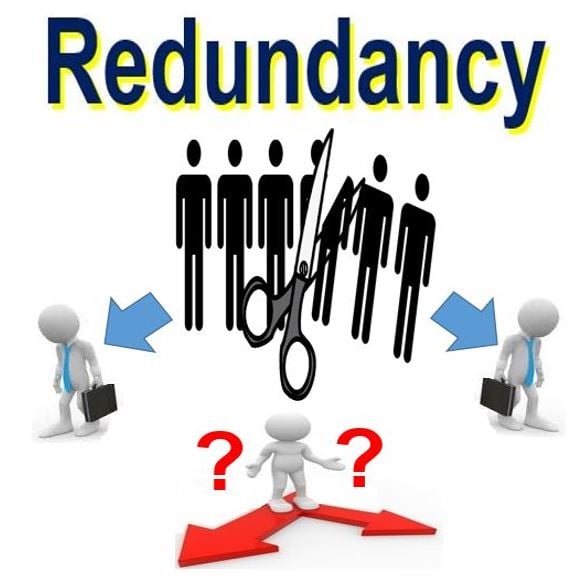Redundancy Pay If Company Goes Bust: Understanding Your Privileges in the UK
Redundancy Pay If Company Goes Bust: Understanding Your Privileges in the UK
Blog Article
Checking Out the Interaction In Between Firm Redundancy and Business Flexibility for Future Growth
In the dynamic landscape these days's service world, the complex partnership between business redundancy and business versatility emerges as a vital factor for sustained development and success. Business typically deal with the difficulty of striking a delicate equilibrium in between preserving a degree of redundancy to minimize risks and promoting versatility to react quickly to the ever-evolving market demands. This delicate interplay holds the crucial to not just surviving in rough times but also growing when faced with uncertainty. As we explore the multifaceted dimensions of this interplay, fascinating understandings right into exactly how companies browse these complexities to lead the way for future development await.
Relevance of Firm Redundancy
Company redundancy is a vital aspect that improves business strength and mitigates functional dangers. By including redundancy procedures within the business structure, firms can better withstand unexpected disruptions and fluctuations in business environment. Redundancy works as a strategic buffer, permitting firms to adapt and react efficiently to unexpected challenges without endangering vital procedures.
One secret facet of the significance of firm redundancy is its role in ensuring continuity throughout times of crisis. When faced with unexpected changes or emergency situations, redundant systems, sources, or personnel can action in to keep important functions and protect against widespread disruptions. This continuity not only safeguards the firm's track record and consumer trust yet likewise decreases financial losses and operational downtime.

Techniques for Organizational Adaptability

Another essential method is purchasing modern technology and facilities that can sustain adaptability and scalability. Applying digital devices, automation, and information analytics can improve operations, improve effectiveness, and provide important insights for informed decision-making. Additionally, developing versatile business frameworks that permit fast changes to market dynamics and client requirements is crucial for staying affordable in a swiftly developing environment. By proactively identifying possible interruptions and possibilities, companies can proactively flourish and adjust in an ever-changing service landscape.
Harmonizing Redundancy and Versatility
Achieving a harmonious equilibrium between operational redundancy and organizational adaptability is critical in browsing the complexities of a vibrant service setting. Striking the right balance between redundancy and versatility is a fragile procedure that needs a deep understanding of the company's goals, market characteristics, and danger resistance.
To accomplish this equilibrium, companies need to conduct routine analyses of their procedures to determine areas where redundancy is required for risk mitigation and where flexibility can drive innovation and development. Implementing versatile frameworks, cultivating a society of constant knowing and renovation, and motivating open communication throughout all degrees of the company are vital methods to harmonize redundancy and flexibility properly. By straightening these two crucial components, business can place themselves for sustainable development and success in an ever-changing business landscape.
Study on Adaptation Success
In examining circumstances of successful organizational adaptation, it comes to be apparent that the interaction between operational redundancy and adaptability is a specifying variable in shaping resilient services. A DVD rental service, Netflix showed exceptional adaptability by transitioning into a streaming platform when digitalization interfered with the market. These case researches highlight the relevance of operational redundancy combined with business adaptability in promoting long-term development and competitiveness.
Structure Durability for Future Growth
Structure strength for future development calls for a strategic placement of operational processes with market characteristics and arising fads. Companies have to adjust to changing atmospheres by fostering a society of adaptability, innovation, and continual renovation.
Additionally, cultivating strong partnerships with stakeholders, such as customers, staff members, providers, and the area, is vital for maintaining and weathering uncertainties count on and support throughout stormy times. Effective communication and transparency play an important function in building strength, as they assist facilitate and line up assumptions partnership in navigating uncertainties.
Additionally, companies need to prioritize understanding and advancement initiatives to upskill staff members and equip them with the necessary devices to adapt to changing circumstances. By spending in their labor force, firms can boost their versatility and agility, inevitably reinforcing their durability for sustainable future development.
Verdict

In the dynamic landscape of today's organization globe, the intricate connection between business redundancy and organizational adaptability emerges as a vital element for continual growth and success. Business frequently face the challenge of striking a delicate balance in between keeping a degree of redundancy to reduce threats and promoting adaptability to react quickly to the ever-evolving market needs.To attain this balance, firms require to conduct routine evaluations of their operations to identify locations where redundancy is essential for risk reduction and where flexibility can drive development and development.In redundancy if company goes bust final thought, the interplay between business redundancy and organizational flexibility is essential for future development. Building strength via a combination of redundancy and versatility will make sure that firms are prepared for the challenges of the future.
Report this page